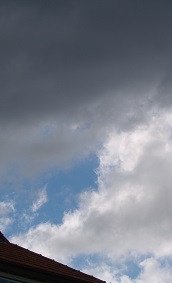Why Do Thunderstorms Occur?
 A storm may be described as any disturbance in the state of an atmosphere which results in an effect on the associated surface and severe weather. Storms are typically associated with strong winds, rain and/or other precipitation such as hail and snow. Strong winds are also associated with storms as are substance storms such as dust storms and sandstorms.
A storm may be described as any disturbance in the state of an atmosphere which results in an effect on the associated surface and severe weather. Storms are typically associated with strong winds, rain and/or other precipitation such as hail and snow. Strong winds are also associated with storms as are substance storms such as dust storms and sandstorms.
Thunderstorms
Thunderstorms have thunder and lightning as key elements. They form when warm, humid air rises in an unstable environment. The mechanisms by which the cumulonimbus clouds responsible for thunderstorms are formed vary, depending on the types of thunderstorm in question. Warm air m ay rise for a number of reasons such as when it is forced uphill, as a consequence of solar heating, where there are low pressure troughs, or where different air streams come together.
As warm, humid air rises it cools and the moisture condenses resulting in cloud formation. As the cloud continues to rise water droplets become larger and may turn into ice crystals if the temperature is low enough. When it reaches more than 10km in height it forms a cumulonimbus cloud which can then produce a thunderstorm.
There are two types of thunderstorm. The first is an air-mass thunderstorm and is associated with clouds that form within maritime tropical air masses. The resulting storms are short and scattered, and rarely produce hail or strong winds. The second is one formed from uneven surface heating plus the lifting of warm air. These storms frequently draw air from levels below them and may produce strong winds, hail, flash floods and tornadoes.
 The wind turbulence inside cumulonimbus clouds causes water droplets and ice particles to break apart and become electrically charged. When this happens positively charged particles form the upper layer and negatively charged particles form the lower layer. As the voltage difference between the layers of charged particles becomes large enough electrostatic discharges take place between clouds or between the clouds and the surface of the earth. This is what we see as lightning. Each lightning strike is highly heated and this heat causes expansion of the air through which it travels. This expansion in turn causes the sound we refer to as thunder. Although lightning and thunder happen at almost the same time we always see the lightning first as light travels faster than sound.
The wind turbulence inside cumulonimbus clouds causes water droplets and ice particles to break apart and become electrically charged. When this happens positively charged particles form the upper layer and negatively charged particles form the lower layer. As the voltage difference between the layers of charged particles becomes large enough electrostatic discharges take place between clouds or between the clouds and the surface of the earth. This is what we see as lightning. Each lightning strike is highly heated and this heat causes expansion of the air through which it travels. This expansion in turn causes the sound we refer to as thunder. Although lightning and thunder happen at almost the same time we always see the lightning first as light travels faster than sound.
Three types of lightening exist. The first of these is intra-cloud lightning (IC), the second cloud-to-cloud (CC) and the third between a cloud and the ground (CG).
Rain may occur during or before thunderstorms when water droplets inside the cumulonimbus clouds can no longer be held up by underlying air resistance. When air rushes downwards rapidly it can produce squalls.
Cyclones, Typhoons and Hurricanes
Cyclones, typhoons and hurricanes are essentially the same type of storm, caused by the same meteorological circumstances. The only difference between them is where they occur. This is the factor which will determine how they are named.
A storm of this type is a system of rapidly circulating air massed about a low-pressure centre, usually accompanied by destructive weather.
These storms rotate about this central axis, with the direction being clockwise in the southern hemisphere and counter-clockwise in the northern hemisphere. This is true for all three of these events.
Storms of this magnitude beginning in the Southern Pacific are called cyclones, cyclones in the Northwest Pacific are called typhoons, and those occurring in the North Atlantic, or NE Pacific Oceans east of the International Date Line, or the South Pacific Ocean east of 160E, are called hurricanes. Typhoons and hurricanes are only classified as such if wind speeds reach or exceed 74 mph.